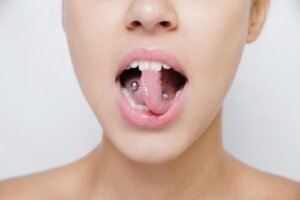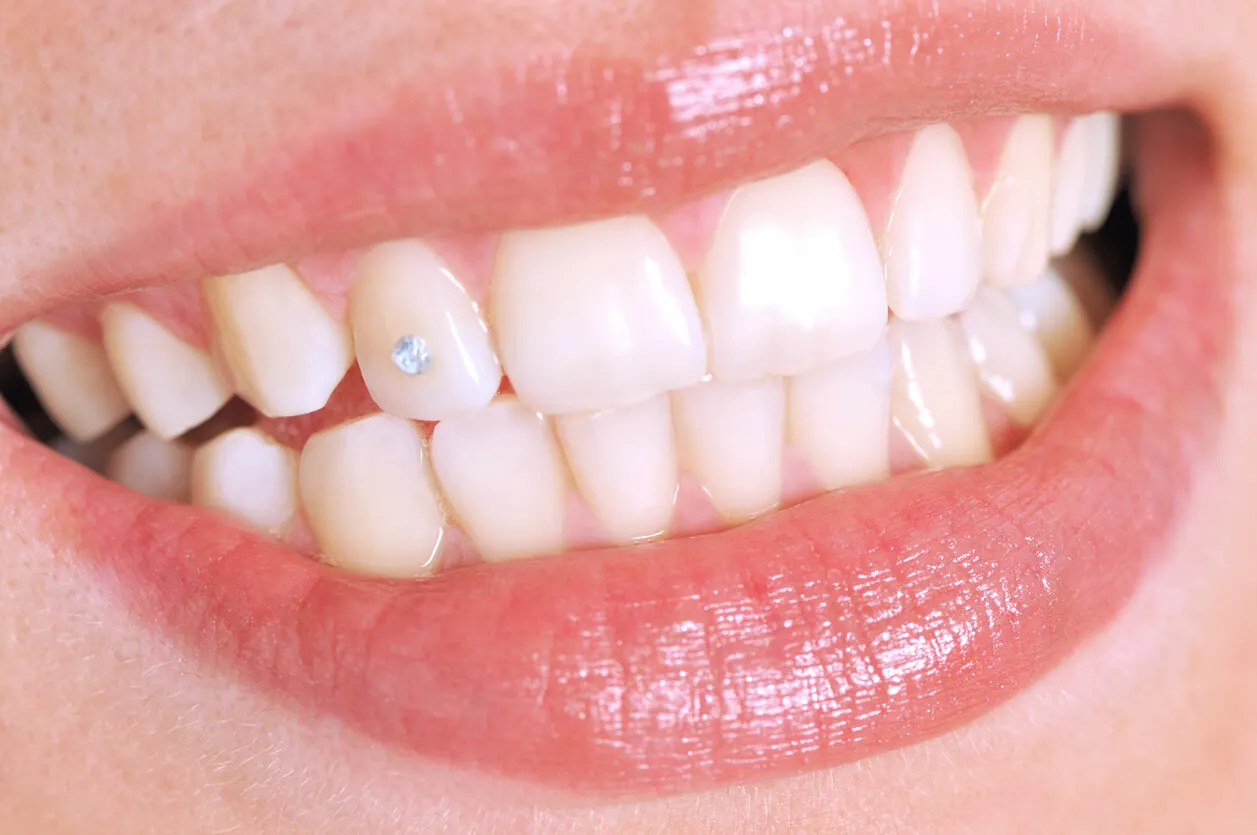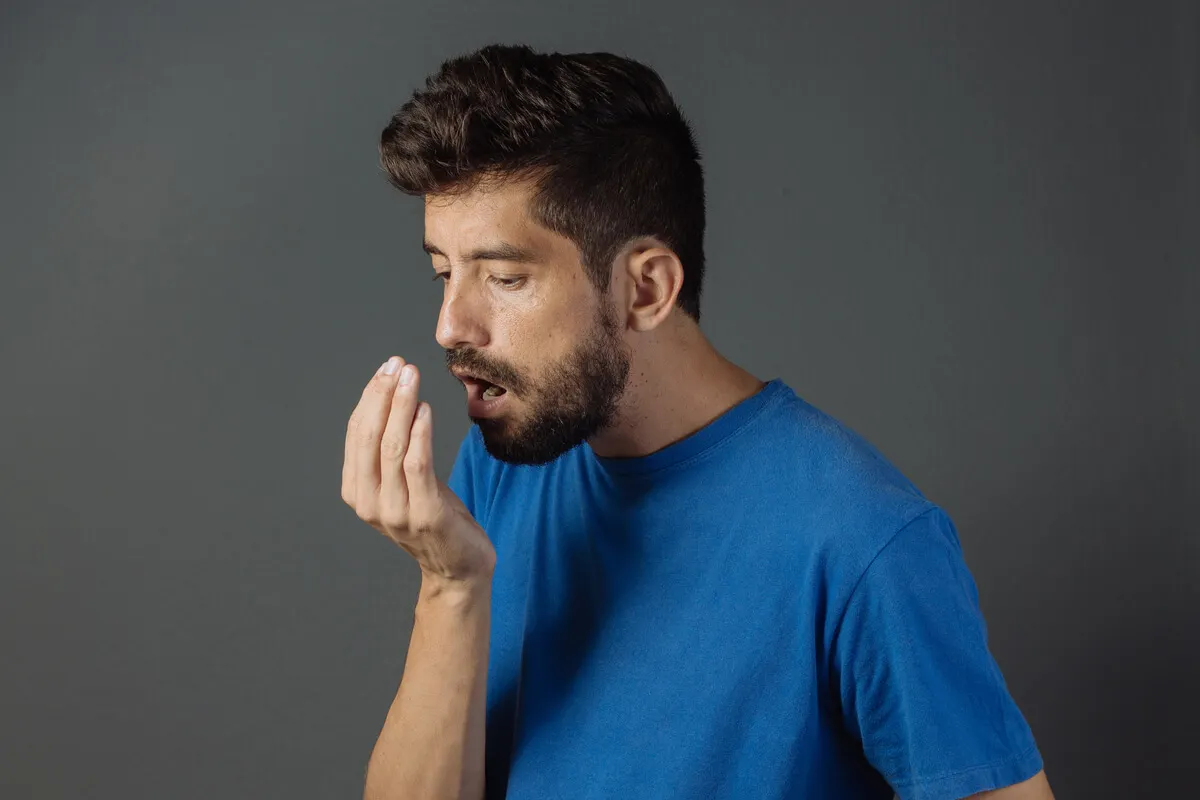Did You Know that Mouth Piercings Could Have Oral Health Consequences?


Written and verified by the dentist Vanesa Evangelina Buffa
Wearing piercings on the body is an increasingly common practice. The ears, nose, eyebrows, navel, and many other places are the most common places of choice to wear these decorative elements. However, when placing a piercing in the mouth, there may be consequences on oral health. Here, we’re going to tell you about them.
Placing a piece of jewelry on the tongue, lips, frenulum, or cheeks can cause damage to the mouth. Also, it can give rise to other complications that affect a person’s overall health. This is because it’s a foreign body in a moist place with a high number of bacteria and in constant movement.
Problems can occur at the time the jewelry is placed. However, they can also occur after it has already been installed. Read on and find out about the consequences of mouth piercings on oral health.
Mouth piercings
Piercings are jewelry that is inserted into the skin or mucous membranes through a perforation of the membranes. In general, they’re metallic or ceramic, although they can be found in different materials and with different designs.
This practice dates back to ancient cultures. However, it has gained popularity since the 1990s, and today it’s quite common, especially among young people and teenagers.
As mentioned, this type of accessory can be placed in various areas of the body. In this article, we will focus on those that are placed in the mouth.
The oral cavity has several areas which piercing lovers choose to wear their jewelry:
- The tongue: Jewels called barbells are worn in the central part of the tongue. This is a bar that has a small metal sphere at each end. Some people also prefer to wear rings on the sides and on the tip of this organ.
- The lips: Piercings can be placed anywhere along the lip perimeter, although they are most commonly seen in the central part of the lower lip or on the skin, near the chin crease. Rings or studs are usually used, which are a bar with a sphere on the outside and a flat disc on the inside that acts as a closure.
- The cheeks: This type of piercing is external and is visible on the face. However, the piercing also reaches the jugal mucosa inside the mouth.
- Other body parts: Some people choose to place their piercings in the lingual frenulum, below the tongue, and in the uvula, in the anterior sector of the throat. These are less common and more hazardous to a person’s health.

The consequences of mouth piercings on oral health
From the moment of the perforation of the oral tissues to placing a piercing in the mouth, negative consequences for oral health may already appear. In addition, after the jewelry is placed, its presence in the oral cavity also causes other damages and injuries. Here are the risks.
Bleeding, pain, and oral inflammation
One of the consequences on oral health when placing a piercing in the mouth is the risk of bleeding. If the needle goes through a major blood vessel during the placement of the jewelry, there will be a lot of bleeding that will be difficult to stop.
Pain and swelling of the area are also frequent effects after undergoing a piercing. If the jewelry is placed on the tongue, it’s important to be aware of the enlargement of this organ. In severe cases, the airways could become obstructed and make it difficult for air to enter.
Oral infections
Many bacteria coexist in the oral cavity and can find an ideal environment to live and proliferate in a piercing. If this multiplication of germs gets out of control, it will lead to infections inside or outside the mouth.
Infections can occur after the placement of the jewelry, when the wound has not yet finished closing. However, they can also occur sometime after the piercing has been placed.
Infections are associated with careless practice that doesn’t take into account asepsis and adequate biosecurity measures for the operation. Touching the piercing with the hands, putting objects in the mouth, and smoking also increase the risk of this complication.
Infections can be localized in the organ where the jewelry is located, favor contamination of other sites such as the gums, or spread to the whole mouth. It can even affect other areas of the body. The piercing acts as a way for germs to enter the body and spread from there.
Infections due to piercings can become complicated and lead to endocarditis, facial cellulitis, Ludwig’s angina, and bacteremia. That’s why it’s essential to see a doctor urgently in case of fever, redness, swelling, or discharge of pus near the piercing, as well as if you notice any symptoms of inflammation of the face, tremors, or chills.
We think you may also enjoy reading this article: I Have a Lump Around a Piercing: What Can I Do?
Alteration of the functioning of the mouth
The presence of a foreign body in the oral cavity can affect several of the oral functions. Thus, wearing a piercing in the tongue, lips, cheeks, or uvula can cause the following alterations:
- A mouth piercing can excessively increase saliva production.
- It can hinder a person’s speech and make it difficult to pronounce certain phonemes.
- It can hinder the chewing and swallowing of food
- This type of piercing can cause a loss or alteration of a person’s sense of taste.
Periodontal disease
The occurrence of periodontal disease as a consequence of oral health by a piercing in the mouth is linked to infections. The jewelry favors the proliferation of pathogenic bacteria in the oral environment, affecting all tissues.
In the presence of germs, the gums become irritated and inflamed. This leads to what is known as gingivitis. The gingival tissue becomes red, bleeds easily, and bothersome.
If this isn’t treated in a timely manner, bacteria reach deeper areas, and pyorrhea or periodontal disease appears. The tissues that support the teeth are compromised, and the bone that houses them is destroyed. The teeth also can begin to shift and can even fall out.
People who wear oral piercings should take special care to maintain proper oral hygiene. In addition, if they notice that their gums are swollen, bleeding, and appear bright red, they should visit a dentist immediately. This is a warning sign of a periodontal problem.
Gum recession
Gum recession is one of the most common and frequent oral health consequences associated with mouth piercing. It’s mostly linked to jewelry placed on the lips.
When constantly rubbed and traumatized by the piercing, the gingival tissue recedes towards the most apical area of the tooth. This leaves a part of the root of the tooth uncovered, giving it the appearance of a longer tooth.
When the gum is positioned in a deeper area, the tooth loses insertion and can begin to move and even be lost. In addition, gingival recession affects the appearance of the smile and can cause tooth sensitivity and increase the risk of neck caries.
Enamel wear and tooth fractures
In general, oral piercings are made of metallic materials. The constant friction of this element with the dental pieces wears down the dental surface.
When the superficial and protective layer of the teeth is eliminated, other consequences appear, such as dental sensitivity and an increased risk of suffering from cavities.
Fractures of the teeth, crowns, or fillings are another possibility when wearing jewelry in the mouth. Accidents while chewing, constant knocking, or a blow to the piercing against these elements can break or fracture them.
Like this article? You may also like to read: Piercing Rejection: Causes, Treatment and Prevention
Other complications of mouth piercings
In addition to the negative oral health consequences associated with the use of piercing in the mouth that we have already mentioned, there are other problems related to piercings:
- Bad breath: The accumulation of bacteria in the piercing favors the appearance of bad oral odor.
- Blood-borne diseases: The place and conditions of the piercing, especially if performed in unsanitary places, can favor the transmission of serious diseases such as HIV and hepatitis B, C, and D. The disinfection and asepsis of the instruments and needles used are essential to avoid these disorders.
- Endocarditis: As already mentioned, punctures can facilitate the entry of bacteria into the bloodstream and their arrival at the heart. This increases the risk of suffering bacterial endocarditis, with inflammation of the valves and cardiac tissues.
- Allergies: Some people may have a hypersensitivity reaction to the material from which the jewelry is made, especially if it contains nickel.
- Dental malocclusions: The permanent presence of a foreign object in the mouth modifies how a person bites to adapt to this external body and alters the balance of the tongue force. This, in turn, can affect the position of the teeth and occlusion.
- Ulcers and sores on the mucous membranes.
- Accidental ingestion or aspiration of the oral piercing.

How to reduce the risks if you decide to get a mouth piercing
Now that you know the oral and general health consequences of getting a mouth piercing, you may be hesitant about this fad. However, if you still choose a mouth piercing despite the risks, it’s important that you take into account the following recommendations.
Before deciding to undergo this type of practice, it’s key that you are sure and get all your questions and concerns out of your mind. Don’t do it under social pressure or under the influence of alcohol or drugs.
Talking to people who have already gone through the experience and asking them for suggestions and opinions can be helpful. When in doubt or fear of regret, the best option is always to wait.
When it comes to the placement, it’s essential to look for an authorized place and a trained and experienced professional for the placement of the piercing. It has to be where you ensure adequate hygienic measures and the use of disposable or sterile instruments.
You should know that anesthesia is not used for piercings. The people who perform them are not authorized or trained to inject such substances into the mouth.
The material of the jewelry is also important. You should choose a piercing that’s made of biocompatible and hypoallergenic elements. Surgical stainless steel, titanium, and 14 or 18-karat gold are good options.
After the jewelry is placed, don’t eat or drink hot food or beverages, and do not smoke. This increases the risk of bleeding and inflammation.
Severe pain in the area is unusual. If there’s a lot of discomfort or bleeding, it’s advisable to see a doctor or dentist.
How to take care of a mouth piercing and maintain oral health
Once a piece of jewelry has been placed in the mouth, it’s necessary to take certain precautions to reduce your risk of complications. Here are the practices to always consider:
- Oral hygiene: Taking responsible and correct care of oral hygiene is essential to reduce the proliferation of bacteria. Daily brushing with fluoride toothpaste and flossing should not be overlooked.
- Jewelry cleaning: The piercing should also be carefully cleaned. Accumulation of food debris and bacterial plaque in the area should be avoided. The use of non-alcoholic mouthwash after eating and before sleeping can make this task easier.
- Leave the jewelry in place until it heals: In most people, healing takes about 6 weeks, although it can be extended to several months. To prevent the hole from closing, leave the jewelry in place and do not remove it.
- Removing the piercing: After the area has healed properly, it’s a good idea to remove the piercing to sleep, eat and play sports. Its cleanliness upon removal and before reinserting is also essential.
- Don’t fiddle with the piercing: Although it’s often tempting to twist, nibble, or move the jewelry in the mouth, this should be avoided. This delays healing and increases the risk of injury to the mucous membranes and dental tissues. In addition, it’s also important not to put your hands or other objects in your mouth that could contaminate the jewelry.
- Visit a dentist regularly: Checking the piercing and the rest of the oral tissues helps to detect and treat any problems in time.
Make a responsible decision
As we told you, wearing a piercing in the mouth has negative consequences for oral health. Therefore, placing a metallic element in the thickness of the soft parts of the oral cavity is never a good idea.
However, many people still choose to do it. In these cases, responsibility is essential, as well as looking for the right jewel and going to experts for its placement. Maintenance and subsequent controls will also be necessary, in addition to the availability to remove the accessory if it’s causing problems.
Having the necessary information to make a responsible decision is the first step before opting for a piercing. With the facts and tips we shared here, you will be able to make an informed and responsible decision.
All cited sources were thoroughly reviewed by our team to ensure their quality, reliability, currency, and validity. The bibliography of this article was considered reliable and of academic or scientific accuracy.
- Preslar, D., & Borger, J. (2022). Body Piercing Infections. In StatPearls. StatPearls Publishing.
- Saccomanno, S., Ieria, I., Manenti, R. J., Giancaspro, S., & Pirelli, P. (2021). Complications of oral piercing: a review of the literature and two case reports. Journal of biological regulators and homeostatic agents, 35(3 Suppl. 1), 167–178.
- Ziebolz, D., Söder, F., Hartl, J. F., Kottmann, T., Rinke, S., Merle, C. L., & Schmalz, G. (2019). Prevalence of periodontal pathogenic bacteria at different oral sites of patients with tongue piercing—results of a cross sectional study. Diagnostic microbiology and infectious disease, 95(4), 114888.
- Dibart, S., De Feo, P., Surabian, G., Hart, A., Capri, D., & Su, M. F. (2002). Oral piercing and gingival recession: review of the literature and a case report. Quintessence international (Berlin, Germany : 1985), 33(2), 110–112.
- Schmidt, J. C., Calderaro, S., Weiger, R., & Walter, C. (2019). On the association between oral piercings and periodontal conditions—A case series. International Journal of Dental Hygiene, 17(4), 318-326.
- Kapferer, I., Benesch, T., Gregoric, N., Ulm, C., & Hienz, S. A. (2007). Lip piercing: prevalence of associated gingival recession and contributing factors. A cross-sectional study. Journal of periodontal research, 42(2), 177–183. https://doi.org/10.1111/j.1600-0765.2006.00931.x
- Ravelo, M. J., Báez, F. A. G., Núñez, A. H., & Fiallo, C. J. V. (2016). Oral piercings and their complications in dentistry. Medimay, 22(3), 124-136.
- Tamez, M. A. T., & de León, F. C. (2017). Complicaciones por el uso de piercings orales en adolescentes mexicanos. Revista Mexicana de Estomatología, 4(1), 25-26.
- Escudero Castaño, N., & Bascones Martínez, A. (2007). Posibles alteraciones locales y sistémicas de los piercings orales y periorales. Avances en Odontoestomatología, 23(1), 21-33.
- Díaz, J. C. Q., Corvo, N. V., Giralt, M. Q., & Reyes, D. R. (2018). Complicaciones y efectos negativos asociados al uso de los piercings en la región maxilofacial. Medimay, 25(3), 190-200.
This text is provided for informational purposes only and does not replace consultation with a professional. If in doubt, consult your specialist.








